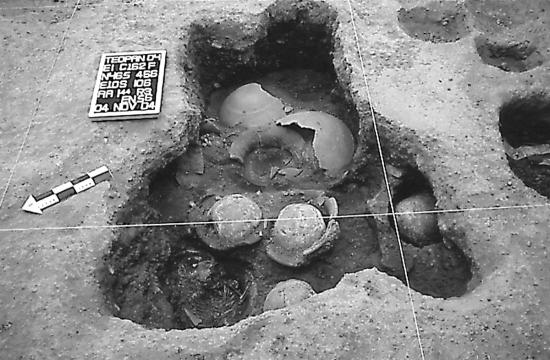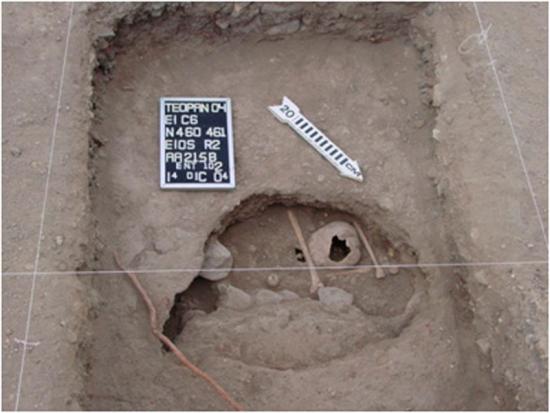Kristina Killgrove
Source - http://www.forbes.com/sites/kristinakillgrove/2015/08/07/teotihuacan-had-one-of-ancient-mexicos-most-diverse-neighborhoods-dna-shows/
The ancient city of Teotihuacan, in the Valley of Mexico, is well known as a large urban center. Established around 100 BC, Teotihuacan grew to be one of the largest cities on the planet by 500 AD, with more than 100,000 people living in the center and the surrounding neighborhoods. Religious buildings like the Pyramid of the Sun and the Pyramid of the Moon are still visited today, and the city boasted multi-level apartment buildings to house its massive population. Many of these people came to Teotihuacan from other parts of the Mesoamerican world, and a new DNA study of the neighborhood of Teopancazco is revealing the genetic diversity of the immigrants.
Writing in the journal PLOS One a few weeks ago, researchers Brenda A. Álvarez-Sandoval and colleagues use DNA analysis to test the hypothesis, based on archaeological evidence of different burial practices and the finding of imported materials, that Teopancazco was a multiethnic neighborhood headed by mid-level political elites. They chose 46 skeletons to subject to DNA analysis, including both men and women, as well as children, whose skeletons are often overlooked in bioarchaeological studies. Preservation of DNA at the site was poor, but the researchers were able to recover mtDNA from 29 of the skeletons.
Through genetic analysis, Álvarez-Sandoval and colleagues found that haplogroup A was most frequent, but haplogroups B, C, and D were also present at Teopancazco. These are well-known haplogroups often found in modern and ancient Native American populations. But the skeletons were from three different periods of occupation — Tlamimilolpa (early), Xolalpan (late), and the transitional period between them — so the researchers looked at frequencies of haplogroups within those periods as well. Haplogroup D was found only in the early and late periods, and is absent in the transitional period between them, but haplogroup C was found twice as often in the early and transition periods compared to the late period. The population in the Teopancazco neighborhood was genetically diverse since its founding.
The transitional phase of the neighborhood population is especially interesting because, the authors write, “differential burial rituals were found, in which some intentionally decapitated individuals, mainly males, were considered foreigners coming from low altitudes and some others coming from the Teotihuacan corridor to the Gulf Coast.” The haplogroup frequencies in this transitional period do indeed show a different pattern compared to the early and late phases, and the DNA evidence backs up previous isotope studies of the origins of the decapitated males.
 Decapitated males from Teopancazco, a neighborhood within the ancient Mexican city of Teotihuacan. Credit: Linda Manzanilla (Image via Phys.org)
Decapitated males from Teopancazco, a neighborhood within the ancient Mexican city of Teotihuacan. Credit: Linda Manzanilla (Image via Phys.org)
 Teopancazco burial ritual in Teotihuacan.
Teopancazco burial ritual in Teotihuacan.
Photo: Linda Manzanilla Naim (Image via Coordinacion de Comunicacion y Divulgacion, Academia Mexicana de Ciencias.)
But what do these haplogroups mean for genetic relationships between Teopancazco and other populations in ancient Mesoamerica? Álvarez-Sandoval and colleagues compared the Teopancazco DNA to groups in the Teotihuacan corridor, Oaxaca, and the Maya region and found that they were similar in their diversity. They also compared the ancient Teopancazco results with DNA from nine modern Native Mexican populations, which showed that the ancient skeletons were close to people from Tepehuan, Zapotec, Maya, and Mixtec populations. “These data suggest that the population of the initial phase of Teopancazco (Tlamimilolpa, AD 200-350) was composed mainly by local people and by foreigners from sites belonging to the Teotihuacan corridor to the Gulf Coast,” the authors explain. The fact that there was limited contact with other distant populations “suggests a lower genetic diversity during this time in comparison to the final phase of the Teopancazco history (the Xolalpan phase), characterized by the possible expansion of exchange routes between Teotihuacan and Mesoamerica,” they conclude.
The researchers also did DNA testing on infants, which is the only way to tell from the skeleton whether the child was male or female, in light of the suggestion that some of these babies may have been sacrificed. In their sample, there were seven female infants and five male infants. More interesting than the balanced sex ratio, though, was the fact that the male infants showed greater genetic diversity. “This is the first time that hypotheses based on genetic data in relation to infant sacrifices in Mesoamerican populations are proposed,” the authors comment, and the data suggest that additional research may produce more answers to the question of child sacrifice at Teotihuacan.
“Before our research,” the authors write, “comprehensive genetic studies aimed to better understand the multiethnicity in this site had not been carried out.” Their results show that, although Teopancazco was genetically diverse, its people came from areas and groups living close by. They are also the first group to suggest, based on DNA data, a relationship between infants and burial styles in the “termination ritual” in the transitional phase of the site.
Understanding where a population came from, how people are related, and how they choose to bury their dead was previously done solely through bioarchaeological analysis. But the advent of faster, less expensive methods of DNA analysis is adding a new facet to ancient populations. Álvarez-Sandoval and colleagues’ study of skeletons from a Teotihuacan neighborhood clearly show the potential in correlating genetic data with osteological data from skeletons and archaeological data from burials to answer longstanding questions about people of the past.
For more information, or to read the open-access article, see: Álvarez-Sandoval BA, Manzanilla LR, González-Ruiz M, Malgosa A, Montiel R (2015) Genetic Evidence Supports the Multiethnic Character of Teopancazco, a Neighborhood Center of Teotihuacan, Mexico (AD 200-600). PLoS ONE 10(7): e0132371. doi:10.1371/journal.pone.0132371.